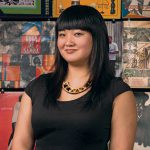
As an information professional committed to social justice and employing a critical lens to examine the impact of our work, I always look forward to seeing how these principles and issues of diversity and representation of the profession and historical record are more widely discussed in national forums. In my new role as Librarian for Digital Collection Development at UCLA’s Digital Library Program, I grapple with how our work as a digital library can serve our predominantly people of color campus community[1] within the larger Los Angeles context, a city also predominantly comprised of people of color[2]. As a first time attendee to DPLAfest, I was particularly interested in how DPLA frames itself as a national digital library for a country that is projected to have a majority person of color population by 2060.[3] I observed that the DPLAfest leadership did not yet reflect the country’s changing demographics. The opening panel featured eight speakers yet there was only one woman and two people of color.
The opening panel of DPLAfest was filled with many impressive statistics – over 13 million items in DPLA, over 1900 contributors, over 30 partners, over 100 primary source sets, with all 50 states contributing. While these accomplishments merit celebration, I appreciated Dr. Kim Christen Withey’s Twitter comment that encourages us to consider alternate frameworks of success: “#DPLAfest lots of talk of numbers–presumably the bigger the better–how else can we think about success? esp in the digital content realm?”[4]
While the amount of materials or information we have access to is frequently used as a measure of success, several panels such as The People’s Archives: Communities and Documentation Strategy, Wax Works in the Age of Digital Reproduction: The Futures of Sharing Native/First Nations Cultural Heritage, and Technology Trends in Libraries encouraged nuanced discussions of success through its discussions around the complexities of access. The conversation between Allison Macrina of Library Freedom Project and John Resig of Khan Academy critically interrogated the celebration of big data. Macrina reminds libraries to ask the questions: Who owns big data? What is the potential for exploitation? Who has access? How do we negotiate questions of privacy for individuals yet not allow institutions to escape accountability?
The complexities of access and privacy were further explored in the community archives sessions. Community archivists Carol Steiner and Keith Wilson from the People’s Archive of Police Violence in Cleveland spoke on storytelling as a form of justice in the face of impunity but also the real concerns of retribution for archiving citizen stories of police abuse. Dr. Kim Christen Withey spoke on traditional knowledge labels and the Mukurtu content management system that privileges indigenous knowledge about their own communities and enables a continuum of access instead of a binary open/closed model of access. In both of these cases, exercising control over one’s self and community representation constitutes a form of agency in the face of symbolic annihilation[5] that traditional archives and record keeping have historically wreaked on marginalized communities. Additionally, community investment in these documentation projects outside traditional library and archive spaces have been key to their sustainability. In light of this, Bergis Jules raised the important question of “what is or should be the role of large scale digital libraries, such as DPLA, in relation to community archives?”[6] First and foremost, I think our role as information professionals is to listen to communities’ vision(s) for their historical materials; it’s only then that we may be able contribute to and support communities’ agency in documentation and representation. I’m grateful that participants created space within DPLA to have these nuanced discussions and I’m hopeful that community driven development can be a guiding principle in DPLA’s mission.
For a closer read of the aforementioned panels, see my Storify: Community Archives @ DPLAfest.
[1] UCLA Enrollment Demographics: Fall 2015, http://www.aim.ucla.edu/tables/enrollment_demographics_fall.aspx.
[2] Los Angeles, CA, https://censusreporter.org/profiles/16000US0644000-los-angeles-ca/
[3] Sandra L. Colby and Jennifer M. Ortman, “Projections on the Size and Composition of the U.S. Population: 2014-2060,” US Census Bureau, March 2015, 10, https://www.census.gov/content/dam/Census/library/publications/2015/demo/p25-1143.pdf
[4] https://twitter.com/mukurtu/status/720624390879186945
[5] Defined in Dr. Michelle Caswell’s presentation on “Assessing the Impact of Community Archives” as “the ways in which members of marginalized groups are absent, grossly under-represented, maligned, or trivialized by mainstream media,” https://twitter.com/tttkay/status/720969650784378880/photo/1?ref_src=twsrc%5Etfw.
